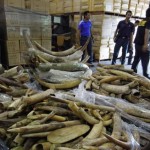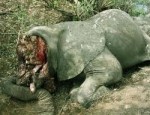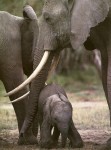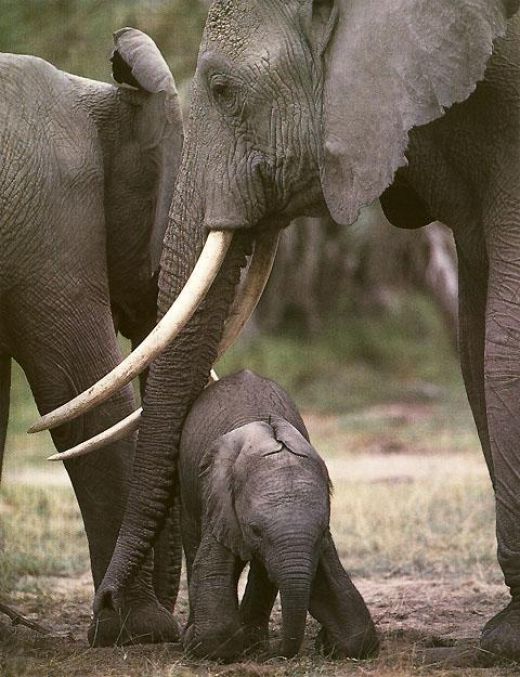 2011 was considered the bloodiest year for elephants since 1989, the same year the ivory ban began. Confiscated ivory from illegal sales estimate over 3000 elephants were killed by poachers to fuel the black market demand; and that is just what was found. In a single month, Malaysian authorities seized over $1.3 million US worth of ivory that was being shipped out of Kenya and into Cambodia. It is well documented that the illegal trade in wildlife and their parts is a multi-billion dollar a year business; third only behind drugs and weapons trafficking. Trade in rhino horn and tiger bone used for unfounded medicinal purposes is fueled by Traditional Chinese Medicine, but what about ivory? Is the slaughter of elephants simply done for aesthetics?
2011 was considered the bloodiest year for elephants since 1989, the same year the ivory ban began. Confiscated ivory from illegal sales estimate over 3000 elephants were killed by poachers to fuel the black market demand; and that is just what was found. In a single month, Malaysian authorities seized over $1.3 million US worth of ivory that was being shipped out of Kenya and into Cambodia. It is well documented that the illegal trade in wildlife and their parts is a multi-billion dollar a year business; third only behind drugs and weapons trafficking. Trade in rhino horn and tiger bone used for unfounded medicinal purposes is fueled by Traditional Chinese Medicine, but what about ivory? Is the slaughter of elephants simply done for aesthetics?
The sole purpose of ivory is for ornamental use. Carved ivory statues, knife handles, jewelry, and ornaments have been used as a sign of status in  China for thousands of years. Ivory carving was at one time an admirable trade, with carvers holding high rank amongst tradesman working within palace walls. However, with the changing times, so too has the need and cultural significance of ivory.
China for thousands of years. Ivory carving was at one time an admirable trade, with carvers holding high rank amongst tradesman working within palace walls. However, with the changing times, so too has the need and cultural significance of ivory.
 African elephants are the only species where both males and females grow ivory tusks. Elephants reach puberty between 11-15 years of age. In addition, the gestation of an elephant is 22 months, with an overall calving interval of ~4-6 years depending on geographical location. It doesn’t take a mathematician to understand that an elephant population can collapse quite easily under pressure from poaching.
African elephants are the only species where both males and females grow ivory tusks. Elephants reach puberty between 11-15 years of age. In addition, the gestation of an elephant is 22 months, with an overall calving interval of ~4-6 years depending on geographical location. It doesn’t take a mathematician to understand that an elephant population can collapse quite easily under pressure from poaching.
It is no secret that the Asian ivory market is the catalyst for the increase in poaching of African elephants. Chinese companies interested in  exploration of minerals, metals, and fossil fuels have purchased land rights in several African countries, and more importantly through millions of acres of priceless wildlife habitat. A recent report from Amboseli National Park officials in Kenya documents an increase in ivory poaching at the same time a Chinese company began construction of a highway in the area. Furthermore, the rise in demand for bushmeat has increased significantly in areas where exploration is being carried out.
exploration of minerals, metals, and fossil fuels have purchased land rights in several African countries, and more importantly through millions of acres of priceless wildlife habitat. A recent report from Amboseli National Park officials in Kenya documents an increase in ivory poaching at the same time a Chinese company began construction of a highway in the area. Furthermore, the rise in demand for bushmeat has increased significantly in areas where exploration is being carried out.
 The simple solution is to decrease demand; unfortunately, getting from the point where we are to the end of the illegal ivory trade is not so simple. Humans hold the future of this planet and all of its inhabitants in their hands. It is only by our decisions that wildlife is illegally killed and habitats are destroyed. As we begin a new year it is time we take a very critical look at what we consider tradition. What actions define a culture and are important enough to pass down to future generations? Regardless of culture, I think we can all recognize that the elephant is something worth keeping. Surely we can all agree that the most beautiful ivory belongs on the face of an elephant.
The simple solution is to decrease demand; unfortunately, getting from the point where we are to the end of the illegal ivory trade is not so simple. Humans hold the future of this planet and all of its inhabitants in their hands. It is only by our decisions that wildlife is illegally killed and habitats are destroyed. As we begin a new year it is time we take a very critical look at what we consider tradition. What actions define a culture and are important enough to pass down to future generations? Regardless of culture, I think we can all recognize that the elephant is something worth keeping. Surely we can all agree that the most beautiful ivory belongs on the face of an elephant.
